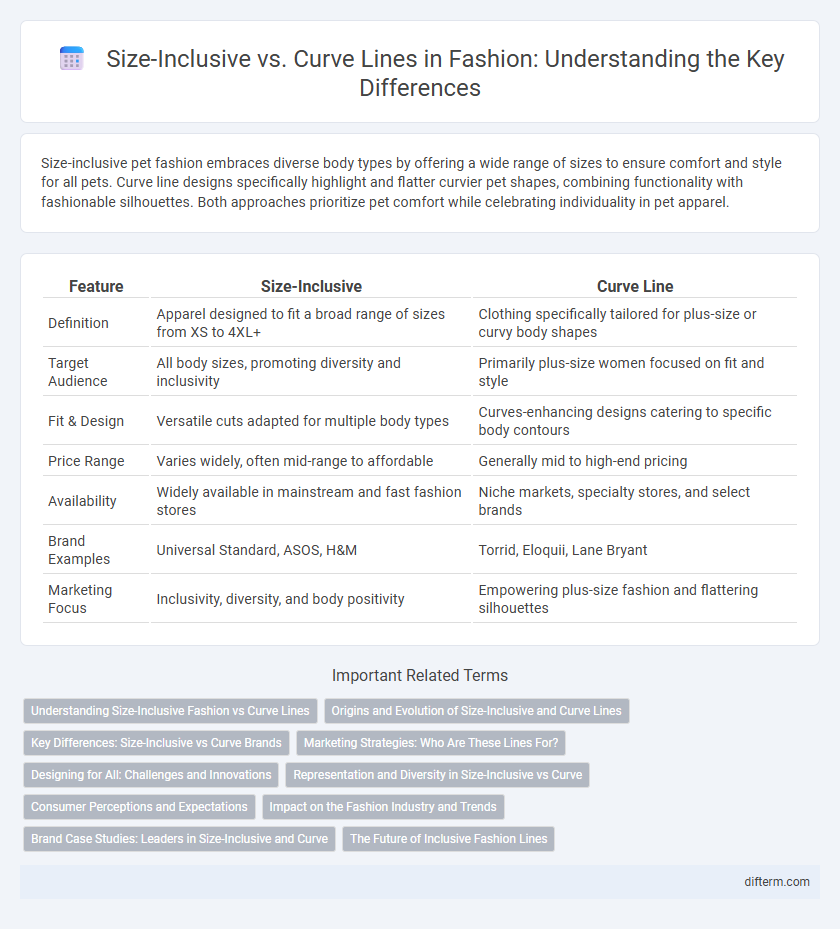Size-inclusive pet fashion embraces diverse body types by offering a wide range of sizes to ensure comfort and style for all pets. Curve line designs specifically highlight and flatter curvier pet shapes, combining functionality with fashionable silhouettes. Both approaches prioritize pet comfort while celebrating individuality in pet apparel.
Table of Comparison
| Feature | Size-Inclusive | Curve Line |
|---|---|---|
| Definition | Apparel designed to fit a broad range of sizes from XS to 4XL+ | Clothing specifically tailored for plus-size or curvy body shapes |
| Target Audience | All body sizes, promoting diversity and inclusivity | Primarily plus-size women focused on fit and style |
| Fit & Design | Versatile cuts adapted for multiple body types | Curves-enhancing designs catering to specific body contours |
| Price Range | Varies widely, often mid-range to affordable | Generally mid to high-end pricing |
| Availability | Widely available in mainstream and fast fashion stores | Niche markets, specialty stores, and select brands |
| Brand Examples | Universal Standard, ASOS, H&M | Torrid, Eloquii, Lane Bryant |
| Marketing Focus | Inclusivity, diversity, and body positivity | Empowering plus-size fashion and flattering silhouettes |
Understanding Size-Inclusive Fashion vs Curve Lines
Size-inclusive fashion offers a broad range of sizes designed to fit diverse body shapes, promoting accessibility and representation across all demographics. Curve lines specifically target plus-size consumers, emphasizing styles that accentuate and flatter fuller figures with tailored cuts and supportive fabrics. Understanding the distinction helps brands cater to varied customer needs by balancing universal fit principles with specialized design for curves.
Origins and Evolution of Size-Inclusive and Curve Lines
Size-inclusive fashion originated as a response to the demand for greater diversity and representation in clothing, expanding traditional sizing to accommodate a wider range of body types. Curve lines evolved specifically to celebrate fuller figures, emphasizing fit and style tailored to plus-size consumers while challenging industry norms. Both movements have transformed the fashion landscape by promoting body positivity and inclusivity through innovative design and marketing strategies.
Key Differences: Size-Inclusive vs Curve Brands
Size-inclusive brands offer a wide range of sizes from XS to 5XL, catering to diverse body types and promoting accessibility. Curve brands specifically target plus-size consumers, emphasizing trend-driven, flattering fits for sizes typically above 12. The key difference lies in audience breadth, with size-inclusive aiming for universal appeal and curve lines focusing on plus-size fashion empowerment.
Marketing Strategies: Who Are These Lines For?
Size-inclusive fashion targets a broad demographic, emphasizing diversity by offering extended size ranges that cater to all body types, including petite, plus-size, and tall consumers. Curve lines specifically focus on plus-size individuals, delivering styles designed to accentuate and flatter fuller figures, often leveraging body positivity marketing to build brand loyalty. Marketing strategies for size-inclusive lines highlight inclusivity and representation across varied body sizes, while curve lines concentrate on empowering plus-size customers through targeted campaigns and influential apparel fit expertise.
Designing for All: Challenges and Innovations
Designing for all body types requires balancing size-inclusive and curve line approaches to accommodate diverse shapes and preferences. Size-inclusive fashion extends across a wide range of measurements, ensuring accessibility, while curve lines emphasize fits that enhance and flatter fuller figures. Innovations in fabric stretch, adaptive tailoring, and digital sizing technology address challenges by providing comfort and style without compromising aesthetics.
Representation and Diversity in Size-Inclusive vs Curve
Size-inclusive fashion embraces a broad spectrum of body types by offering designs that cater to a wide range of measurements, promoting authentic representation and celebrating diversity. Curve lines specifically target plus-size consumers with styles tailored to accentuate fuller figures, fostering body positivity within that demographic. Both approaches challenge traditional beauty standards by enhancing visibility and inclusivity for underrepresented sizes in the fashion industry.
Consumer Perceptions and Expectations
Consumers increasingly demand size-inclusive fashion lines that offer a broad range of sizes to ensure accessibility and body positivity. Curve lines specifically target plus-size demographics with tailored designs that emphasize fit and style, addressing misconceptions about limited fashionable options. Market analysis reveals that shoppers prioritize both inclusivity and garment quality, expecting brands to provide flattering, comfortable clothing that reflects diverse body types.
Impact on the Fashion Industry and Trends
Size-inclusive and curve lines have significantly reshaped the fashion industry by promoting diversity and body positivity, leading to increased representation of various body types. These trends drive brands to expand their size ranges and design aesthetics, impacting marketing strategies and product development. Consumer demand for authentic inclusivity fuels innovation and sets new standards for sustainability and ethical production practices.
Brand Case Studies: Leaders in Size-Inclusive and Curve
Fashion brands like Universal Standard and Eloquii lead the size-inclusive and curve market by offering extensive size ranges from 00 to 40, demonstrating commitment to diverse body types. Universal Standard's data-driven approach ensures fit consistency across sizes, while Eloquii emphasizes trend-forward designs specifically tailored for plus-size consumers. These brands use customer feedback and fit technology to refine their collections, setting industry standards for inclusivity and style in plus-size fashion.
The Future of Inclusive Fashion Lines
Size-inclusive fashion lines emphasize a broad range of sizes, promoting accessibility for all body types and challenging traditional industry norms. Curve lines specifically target plus-size consumers with designs tailored to accentuate and celebrate fuller figures, fostering body positivity and representation. The future of inclusive fashion involves integrating both approaches through innovative fabrics, adaptive sizing technology, and diverse marketing that reflects the full spectrum of body shapes and sizes.
Size-inclusive vs Curve line Infographic

 difterm.com
difterm.com